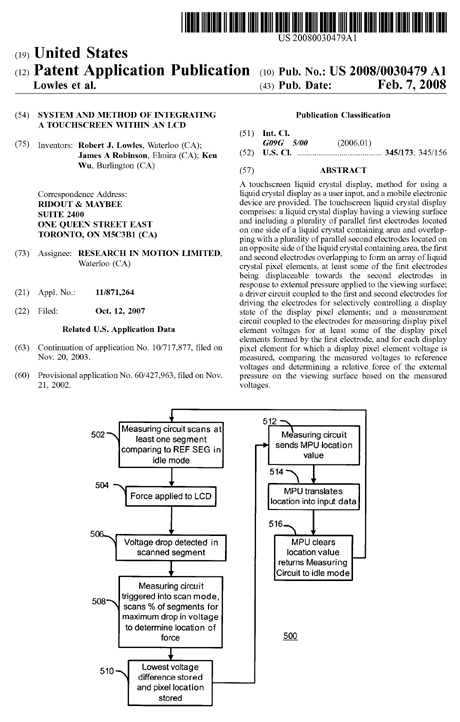Move over, iPhone: touchscreen BlackBerry imminent, clues say

A new BlackBerry Patent application published this morning strongly points to a touchscreen BlackBerry- similar to the touchscreen iPhone.
It's also important to note that although most BlackBerry Patent applications are only published 18 months after they are filed, this one has only a four-month gap. These shorter gaps often occur when adaptation of proposed technology the patent describes is imminent.
The Patent app I am referring to here is System and Method for Integrating A Touchscreen Within an LCD.
The Patent Abstract describes what's being proposed:
A touchscreen liquid crystal display, method for using a liquid crystal display as a user input, and a mobile electronic device are provided. The touchscreen liquid crystal display comprises: a liquid crystal display having a viewing surface and including a plurality of parallel first electrodes located on one side of a liquid crystal containing area and overlapping with a plurality of parallel second electrodes located on an opposite side of the liquid crystal containing area, the first and second electrodes overlapping to form an array of liquid crystal pixel elements, at least some of the first electrodes being displaceable towards the second electrodes in response to external pressure applied to the viewing surface; a driver circuit coupled to the first and second electrodes for driving the electrodes for selectively controlling a display state of the display pixel elements; and a measurement circuit coupled to the electrodes for measuring display pixel element voltages for at least some of the display pixel elements formed by the first electrode, and for each display pixel element for which a display pixel element voltage is measured, comparing the measured voltages to reference voltages and determining a relative force of the external pressure on the viewing surface based on the measured voltages.
Follow along for more explanation from the Patent Application's literature.
The present disclosure provides a touchscreen which is integrated into an LCD by using the electrodes that forms the pixels to measure voltage differences to locate a point of contact, and a method for controlling a touchscreen with integrated LCD.
In accordance with one example embodiment of the present disclosure, there is provided a touchscreen liquid crystal display, comprising: a liquid crystal display having a viewing surface and including a plurality of parallel first electrodes located on one side of a liquid crystal containing area and overlapping with a plurality of parallel second electrodes located on an opposite side of the liquid crystal containing area, the first and second electrodes overlapping to form an array of liquid crystal pixel elements, at least some of the first electrodes being displaceable towards the second electrodes in response to external pressure applied to the viewing surface; a driver circuit coupled to the first and second electrodes for driving the electrodes for selectively controlling a display state of the display pixel elements; and a measurement circuit coupled to the electrodes for measuring display pixel element voltages for at least some of the display pixel elements formed by the first electrode, and for each display pixel element for which a display pixel element voltage is measured, comparing the measured voltages to a reference voltage and determining a relative force of the external pressure on the viewing surface based on the measured voltages.
In accordance with another example embodiment of the present disclosure, there is provided a method for using a liquid crystal display as a user input, the liquid crystal display having a viewing surface and including a plurality of parallel first electrodes located on one side of a liquid crystal containing area and overlapping with a plurality of parallel second electrodes located on an opposite side of the liquid crystal containing area, the first and second electrodes overlapping to form an array of liquid crystal pixel elements, at least some of the first electrodes being displaceable towards the second electrodes in response to external pressure applied to the viewing surface, the method comprising: (a) selectively driving the first and second electrodes to cause the pixel elements to display an image visible on the viewing surface; (b) sampling voltages between the first and second electrodes; (c) comparing the measured voltages to a reference voltage; and (d) determining a relative force of the external pressure on the viewing surface based on the measured voltages.
In accordance with a further example embodiment of the present disclosure, there is provided a mobile electronic device, comprising: a processor for controlling the operation of the device; a touchscreen liquid crystal display for display an image visible from a viewing surface, comprising: a liquid crystal display including a plurality of parallel first electrodes located on one side of a liquid crystal containing area and overlapping with a plurality of parallel second electrodes located on an opposite side of the liquid crystal containing area, the first and second electrodes overlapping to form an array of liquid crystal pixel elements, at least some of the first electrodes being displaceable towards the second electrodes in response to external pressure applied to the viewing surface; a driver circuit coupled to the first and second electrodes for driving the electrodes for selectively controlling a display state of the display pixel elements; and a measurement circuit coupled to the electrodes for measuring display pixel element voltages for at least some of the display pixel elements formed by the first electrode, and for each display pixel element for which a display pixel element voltage is measured, comparing the measured voltages to a reference voltage and determining a relative force of the external pressure on the viewing surface based on the measured voltages.
I'd expect to see a touchscreen BlackBerry within months.
